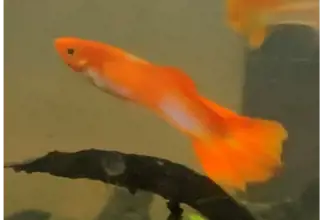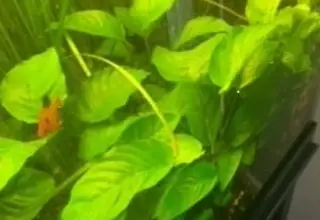Red Dragon Flowerhorn Cichlid: Care, Lifespan, Breeding & More
Posted by Miles Harrison on 11/01/2022
We use affiliate links and may receive a small commission on purchases.
Red Dragon Flowerhorn cichlids are a controversial species. These fish are hybrids, meaning they’ve been developed through decades of cross-breeding by other aquarium hobbyists. Luckily, for aquarists looking to own one of these unique-looking fish, they’ve been around for over 20 years, which means there is plenty of available information online.
In this guide, we’re going to cover everything you’ll need to decide whether or not a Red Dragon Flowerhorn is the fish for you. We’ll discuss the history behind the species, its lifespan, diet, and general care requirements.
January's Giveaways on Light Fish
Species Summary
To understand why the Red Dragon Flowerhorn Cichlid is so popular, you’ll want to know a bit about its history. These fish have origins in Asia, specifically Taiwan and Malaysia, where flowerhorn fish breeding became popular in the early 1990s. While many aquarists viewed fish with protruding foreheads as unsightly, this genetic feature was highly prized in Malaysian and Taiwanese culture, where it was associated with luck and good fortune.
Fish like Trimac cichlids and Red Devil Cichlids were crossbred to accentuate the protruding head feature. Meanwhile, Parrotfish breeding was also becoming more popular. Crossbreeding Parrotfish with Trimac and Red Devil cichlids, eventually produced what is now known as the Flowerhorn Cichlid.
Red Dragon Flowerhorns are a color variation of the traditional Flowerhorn Cichlid, and they’re highly prized for their pinkish/red color. Whether you’re for or against keeping hybrid fish species, we’re going to cover as much as possible about this fish so that you can be as well-informed as possible.

Appearance
Red Dragon Flowerhorns should either have pinkish bodies that transition to red towards their faces, or they should be completely red in coloration. These fish should have upturned mouths with pink lips, and their eyes should be solid-red in color. Red Dragon Flowerhorns have interesting color patterns, metallic-white dots are present throughout the body of the fish, and a black, curvy pattern can usually be seen horizontally across the fish’s midsection.
The tips of the anal, dorsal, and caudal fins should be slightly translucent. The anal and dorsal fins of adult red dragon flowerhorns typically span 1-2 inches in length and taper to a point. Pectoral fins should be a translucent pinkish color, and the fish’s most prominent feature, its enlarged head can vary in size, with larger-sized heads typically being the most prized.
Seeing this fish in person is a sight to behold, there are few fish that resemble the appearance of a red dragon flowerhorn.
Size
While these fish are often sold as juveniles, adult Red Dragon Flowerhorns can get quite large, and have been reported to grow to reach 12 inches in length.
Since Red Dragon Flowerhorns are the result of selective breeding, you’ll want to look to the fish’s parents to get an estimate on their fully grown adult size. While juveniles may only be 2-3 inches when sold, it’s more than likely that they will grow to be much bigger. Always make sure you’re purchasing from a trusted breeder who can answer questions about size.
🛒 Shop Freshwater Fish on Light Fish
Red Dragon Flowerhorn Cichlid Care
Since these fish have no native habitat in the wild, you’ll want to make sure you have a good understanding of their care requirements. There is a lot of misinformation about caring for hybrid fish species, so you’ll want to make sure you’re aware of their care requirements.
Luckily for hobbyists, the red dragon flowerhorn cichlid has been around for quite a few years now, so there are already established guidelines and best practices to follow when caring for this species.
Lifespan
The Red Dragon Flowerhorn is a long-lived species, and adult fish have been documented to live for up to 12 years. Typically, these fish will be sold as juveniles, when they’re only a few months old, so you’ll want to be aware that you’ll be caring for these fish for a long time.
As with almost all aquarium fish, you can give your Red Dragon Flowerhorn the best chance at living a long and healthy life by providing them with nutrient-rich food, and maintaining proper water conditions for the duration of their lives.
Tank Size
Red Dragon Flowerhorns are large freshwater fish, so you’ll want to be sure you have an aquarium that’s at least 50 gallons in size. These fish are quite large, so the more space you have, the better.
Having such a large aquarium will give them plenty of room to swim, and it will also make for a stress-free living environment. Given their aggressive nature, the last thing you’ll want to have is an aquarium that’s too small for this species.
Water Conditions
We won’t be able to replicate the Red Dragon Flowerhorn's native environment, because it doesn’t have one, but we can try to mimic the environment of related fish. Trimac Cichlids serve as an excellent model for Red Dragon Flowerhorns. They thrive in slow-moving, warm, pH-neutral waters in Central America.
Aim for the following water parameters when keeping Red Dragon Flowerhorns:
Temperature Range: 72°F-80°F
pH Range: 6.5–7.5
KH: 8-19 DKH
You’ll want to make sure Ammonia and Nitrite levels are consistently at 0ppm. We recommend purchasing a reliable water test kit and periodically testing your water. If you are concerned that pH might be an issue, you can test your tap water pH range with a PH test kit .
Tank Setup
You’ll want to have plenty of open-swimming space for your Red Dragon Flowerhorn Cichlid. It’s important not to overcrowd your aquarium with too many plants, or hard objects such as stones and driftwood. These fish are active swimmers, so they’ll appreciate plenty of open space.
We always recommend creating an environment that simulates nature, so natural stones and driftwood can be added sparingly.
Like other large freshwater cichlids, Red Dragon Flowerhorns will pick at roots and plants. It is possible to keep aquatic plants with this species, but opt for slow-growing plants, such as Anubias Barteri or Anubias Frazeri. These plants tend to be a bit more durable and can withstand the investigative nature of these fish.
For substrate, we recommend nutrient-rich substrates, such as CaribSea’s eco-complete . The nutrients provided by these substrates will be consumed by live aquarium plants, which in turn help improve the quality of your aquarium water.
You’ll also want to purchase a reliable aquarium heater that’s suitable for your aquarium size. We recommend an aquarium thermometer , which will allow you to monitor temperatures so that they are consistent.
Common Diseases
Red Dragon Flowerhorns are susceptible to the same diseases as most freshwater aquarium fish, but they are especially vulnerable to hole-in-the-head disease.
This disease is common with cichlids, discus, and oscar fish, and its origins are still not confirmed. It’s suspected that the disease is related to a parasite, taking advantage of a weakened fish’s immune system. Others suspect vitamin deficiencies could be a primary cause.
Treatment for hole-in-the-head disease typically involves Metronidazole, a common antibiotic used to treat bacterial infections.
Another disease seen in Red Dragon Flowerhorns is called Ich, or white spot disease. Symptoms typically include small white spots on the body of the fish. Your fish may also appear to be much more lethargic. This disease is caused by a parasite and is often seen in aquariums that have poor water quality. Treatment typically involves adding a small amount of aquarium salt, increasing water temperatures, and then treating with a liquid solution such as API Super Ick Cure.
The best treatment for any sort of aquarium disease is prevention! Maintaining pristine water conditions, and feeding your fish the most nutrient-rich foods, will strengthen your fish's immune systems. Strong immune systems are a big factor in preventing these common diseases from taking hold.

Food & Diet
Red Dragon Flowerhorn cichlids are big eaters and should be fed a diet of high-quality nutrient-rich flake food at least twice a day. You can supplement their omnivorous diet with pellet food, brine shrimp, and daphnia.
Thawed frozen blood worms can also be fed as an occasional treat, just be careful not to overfeed. Only feed enough food for your fish to consume over 2 minutes. Overfeeding creates waste, which pollutes the aquarium water. Always monitor your fish during feeding time to make sure available food is being consumed.
Behavior and Temperament
You should be aware that the Red Dragon Flowerhorn is an aggressive species. They are active fish and will swim throughout all sections of an aquarium. These fish have been known to recognize their owners and will swim towards the glass to greet them come feeding time.
These territorial fish act similarly to other cichlid species, so expect them to be quite active. If you notice your Red Dragon Flowerhorn becoming less active, test your waters to ensure optimal water parameters.
🛒 Shop Aquarium Plants Fish on Light Fish
Tank Mates
Because of their aggressive personalities, you need to carefully consider the personalities of additional tankmates. Red Dragon Flowerhorns will nip and attack most peaceful schooling fish, and small invertebrates like Orange Pumpkin Shrimp and Black Mystery Snails will easily be hunted by these fish.
Avoid pairing Red Dragon Flowerhorns with the following fish:
- Neon Tetras
- Cardinal Tetras
- Purple Moscow Guppies
- Blue Diamond Discus
- Galaxy Koi Bettas
- Clown Loaches
- Koi Angelfish
If you’re looking to keep other fish with a Red Dragon, larger more aggressive species are the way to go. If you have an aquarium that’s big enough, the following tank mates should be viable options:
Stay clear of:
- Oscar Fish
- Arowanas
- Electric Blue Jack Dempsey
- Bristlenose Plecos
- Midas Cichlids
If possible, we recommend adding a Red Dragon Flowerhorn Cichlid last in an aquarium, this way the fish that tend to be a bit more peaceful will be able to establish territory.
Breeding
Breeding Red Dragon Flowerhorn cichlids is no easy task. Reputable breeders rarely share their hard-earned secrets, and since these are hybrid fish, it’s incredibly difficult to find a male/female pair that are both fertile. If you’re fortunate to have a fertile pair, you can approach breeding the same way you’d approach breeding any other South American cichlid.
Keep temperatures around 82°F and ensure that pH levels are neutral. Females will lay their eggs on a flat surface and guard them aggressively. You’ll want to perform 20% water changes at least twice a week during this period. If the eggs hatch, the fry will most likely be low-quality and will not survive into adulthood. Surviving fry will need to be transferred into an established breeding tank, where they can be provided a steady supply of food in a pristine environment.
Raising the fry is a difficult process. Water changes need to be performed daily, feedings need to be frequent, and very few fry will make it past 4 months. The ones that survive will be well on their way to becoming healthy adult Red Dragon Flowerhorns.
In Conclusion
As you can see, Red Dragon Flowerhorns have an interesting history, and it’s no surprise that these are popular freshwater fish in places where they are legally available.
With their enlarged foreheads, eye-catching color, and massive size, these fish are some of the most talked about in the hobby.
Now that we’ve covered all of the topics related to the species, the choice is yours. Will the Red Dragon Flowerhorn be your next aquarium fish?
We hope you enjoyed reading this post, we are always looking for feedback, so if you’re interested in contributing, please introduce yourself over on our community forum where we discuss fishkeeping tips and advice!
January's Giveaways on Light Fish














